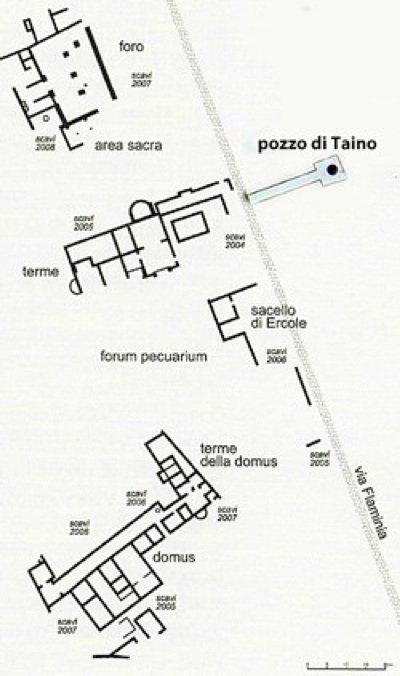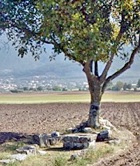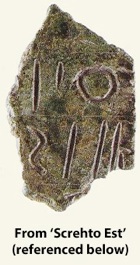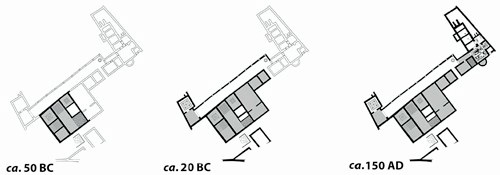


Phases of excavation (2004-8) at “Taino”
Adapted from S. Sisani, (referenced below, 2012, at p. 307)
The website of the Direzione Generale Archeologia summarises the excavations that were carried out under the auspices of the Soprintendenza per i Beni Archeologici dell'Umbria in 2004-8 on a site some some 3 km south west of modern Gualdo Tadino, near Sant’ Antonio di Rasina. The excavated area, which lies along the southwestern side of a surviving stretch of Via Flaminia, was identified as “Taino” in the Catasto Gregoriano (1835), a name that probably derives from the Latin ‘Tadinum’. The excavations uncovered four distinct elements of this part of the Roman city (all marked on the plan above and discussed below):
-
✴an area that seems to be the site of the forum;
-
✴the public baths (thermae);
-
✴a market area (the forum pecuarium), which included a cult site that was probably dedicated to Hercules; and
-
✴a large domus.

According to the website:
-
“The pavement level below the Tiberian phase in the area of the baths date the origin of the settlement to the first half of the 2nd century BC, [suggesting that] this settlement should be viewed in the context of the opening of the Via Flaminia (in 220 BC) and the abandonment of the pre-Roman centre of Colle i Mori [north of the modern city], identified as the Umbrian Tadinum. The abandonment of the Roman city occurred at the beginning of the 5th century AD, with the descent of the Visigoths led by Alaric (408-410 AD) along tthe Via Flaminia. A small area with Lombardic burials dates back to a later phase, as evidenced by numismatic evidence. The only traces of permanent use of the site thereafter are in the (the forum pecuarium, where structures dating back to the 5th century AD evidencing commercial activity have been identified” (my translation).
Before the Social War (90 BC)
The presence of an urban settlement here before the Social War is evidenced by:
-
✴the remains below the Tiberian phase in the area of the baths (see below), which probably date to the first half of the 2nd century BC; and
-
✴three architectural terracottas (ca. 200 BC), entries 332-4 in the catalogue of the Museo Civico, which, according to Francesca Germini (in P. De Vecchi, referenced below, at p. 167), were sporadic finds from Taino and suggest the presence of a cult site here.
Inscription (ca. 200 BC)
-
This fragment of part of the right edge of an inscribed bronze tablet was found here in 2004. According to Simone Sisani and Alberto Calderini (referenced below, p. 271 and Figure 1), it was found by local residents slightly to the north of the excavated area here. These authors speculated (at p. 275) that it might have come from a repository that was found on a nearby site (see their Figure 1) that contained several hundred metal objects dating from the 6th to the 2nd century BC. They also suggested that the fragment had been removed from the original bronze plaque using five separate cuts in order to arrive at a precise weight (8.6 grams).

-
Nine letters in the Latin alphabet can be identified on the surviving fragment:
-
...]ofo
-
...]riei
-
...] ot[..]
According to Alberto Calderini (in L. Agostiniani et al., referenced below, p. 34, entry 26), the inscription is probably in the Umbrian language and, according to Sisani and Calderini (at p. 274), it dates to the late 3rd century BC.
Alberto Calderini summarised the analysis from the earlier paper that had identified a possible correspondence between the content of this fragment and two formulae used in the Iguvine Tables (from Gubbio): Table Ib and Table VIIa both contained these formulae, both of which described the ritual sacrifice of three red or black pigs. He therefore hypothesised (at pp. 34-5) that this fragment from Tadinum was:
-
“... part of a bronze plaque that described a ritual mirroring the Iguvine sacrifice of ‘PORCA. TRIF. ROFA.’ (three red pigs) ...” (my translation).
He commented (at p. 35) that:
-
“This correspondence removes the [apparent] isolation of the Iguvine Tables, not just because [the fragment from Tadinum] represents a new tabula from Umbria but also in relation to the particular type of content. ... the provenance of [this fragment] is also important in this context: it comes from the closest centre to Iguvium, which was itself mentioned as the tota tarinate [‘the Tadinate town’] in the Iguvine Tables and was found ... in the area of the Roman city [of Tadinum]” (my translation).
The surviving fragment is now in the deposit of the Soprintendenza per i Beni Archeologici dell'Umbria, Perugia. The photograph here is from entry 26 of ‘Screhto Est’.
This inscription is also described in the pages on Umbrian Inscriptions after 295BC.
Roman Municipium
Simone Sisani (referenced below, 2014, at p. 191) observed that, following the apparent clearance of the excavated site at Taino in the period straddling the end of the Republican age and the Augusto-Tiberian period, it became:
-
“... largely made up of a series of public building complexes comprising (from north to south):
-
✴the civic forum;
-
✴a rectangular area bounded by porticoes, probably a temple;
-
✴the public baths; and
-
✴the forum pecuarium ....
-
The only domus identified during the excavations, which is of notable proportions, stands in a decentralised position immediately to the south of this public area” (my translation).
These elements are discussed in turn below.
Forum (mid 1st century BC)
The large gravel terraced area to the north, which it overlooks Via Flaminia to the east, was probably the forum of the city. It is limited on four sides by substructures that probably date to the middle of the 1st century BC. The four rectangles marked within it on the plan above would have been the bases of honorary monuments. The foundations of a number of structures, including those of the piers of a large arch, survive to the north and to the west.
Sacred Area (1st century AD)
The area between the forum and the baths consists of a porticoed, probably sacred, area bordered by the southern terrace of the forum. The original portico, which was probably built in the early 1st century AD, was replaced in the 4th century AD.
Public Baths (1st century AD)
This clearly articulated structure, which contained warm and cold rooms, a swimming pool and a gymnasium, ran for some 40 meters along Via Flaminia. The semi-circular fountain (ninfeo) to the north dates to the 2nd century AD. The complex seems to have remained in use until the 4th century AD: the small latrine and the restoration of the marble pavement of the frigidarium probably date to this period.
Forum Pecuarium (1st century BC)
Immediately south of the baths is a large artificial esplanade that is closed to the east (i.e. along Via Flaminia) by a series of rooms. It probably constituted the Forum Pecuarium (animal marke). The area seems to have been restored early in the 1st century AD, and the small rooms along Via Flaminia were probably built (or rebuilt) in the 4th century AD.
Shrine of Hercules (ca. 100 AD)
The building to the south on Via Flaminia, which comprised a small rectangular, east-facing room, was paved in earthenware decorated with geometric motifs. Three inscriptions were discovered in front of it:
-
✴Simone Sisani (referenced below, 2007, at pp. 400-1, entry 98) published an inscription that he dated to ca. 100 AD, which was on what was probably a donarium (donative altar). He suggested that it recorded the names of four donors:
-
•Vibius, Aulus and Marcus Aiedius, sons of Sertoris; and
-
•Titus Soconius, son of Caius.
-
In a later paper (referenced below 2012, at p. 307), he suggested that it probably related to the original construction of this building.
-
✴Simone Sisani (referenced below 2012, at p. 308) published the second inscription, which identified the building as a shrine to Hercules. He transcribed it as:
-
[Sacel]lum Herc[ulis]
-
[sua pe]cunia adme[liorandum curavit]
-
[aqua]m induxit labr[um feci]t statua[m de]
-
[nov]o composuit [et ob de]dicatio[nem]
-
[mulsum] et crustu(lum) [ .... dedit]
-
He suggested that this second inscription related to a restoration of the shrine that had been carried out in the late 2nd century AD.
-
✴Simone Sisani (referenced below 2012, at pp. 134-5, entry 11) reported on a statue base that was found that was found in front of the shrine, which is now in the deposit of the Soprintendenza per i Beni Archeologici dell'Umbria,. It carries an inscription (AE 2013, 0473) that has been transcribed as:
-
[I]mp(eratori) Caes(ari) [M(arco)]/ Antonio/ Gordian[o]
-
Pio Fel(ici) [Inv(icto?)/ Aug̣(usto), po[nt(ifici)]/ max(imo),
-
tr[ib(unicia)]/ p(otestate), p(atri) p(atriae), co(n)[s(uli) II ---?]/ pr(o)c[o(n)s(uli)]
-
... Birr[iu]s S[...]=/nianus mi[l(es) ---] / s(ua) p(ecunia) d(edit) [---]
-
The base probably belonged to a statue of the Emperor Gordian III that had been donated by a knight called “... Birr[iu]s S...nianus”. It probably dates to the period between the second consulate of Gordian III and his death (i.e. 241-4 AD).
Domus (1st century BC)

Phases of construction of the domus at Tadinum
Adapted from Simone Sisani (referenced below, 2014, at p. 193, Figure 3)
This imposing domus of some 2,000 square meters is characterised by a nucleus with mosaic floors and frescoes, fronted by a portico to the north. It also had an extremely large bathing facility of some 200 square meters to the east, which was added in ca. 150 AD. The complex seems to have been built in three distinct phases, as illustrated above. The main room of this part of the complex has a mosaic floor made up of pink and white tesserae that depicts Neptune in a chariot drawn by sea horses. In an adjacent. smaller room, the mosaic depicts Venus looking in a mirror, helped in her toilet by Cupid. According to Simone Sisani (referenced below 2012, at p. 308):
-
“The domus was precociously abandoned in the middle of the 3rd century AD: this testifies to a process of progressive contraction of the settlement, characteristics of centres in the plain [in this period]” (my translation).
Conclusions Drawn by Simone Sisani (2014)
As noted above, the original buildings on the excavated site at Taino seem to have been demolished relatively soon after the Social War. Simone Sisani (referenced below, 2014, at p. 191) observed that:
-
“The urban centre [here then] assumed its definitive form in the decades straddling the end of the Republican age and the Augusto-Tiberian period. From this point, it is largely made up of a series of public building complexes” (my translation).
Sisani related this physical transformation to his model for the administrative development of Tadinum at this time. Thus, he observed (in his English language summary at p. 206) that:
-
“At the present state of research, Tadinum ... appears, at least during the municipal age, as a ‘[city] without homes’, [in which] the ‘city’ coincides with the set of public buildings, a sort of service-place [that was] obviously [related] to a sparse population. The only [building in the excavated area that had residential characteristics] is a major domus built in the late Republican age [described above].”
He stressed that this domus and the adjoining (albeit later) thermal complex were both built on an unusually large scale. In addition, the complex incorporated what he conceived to be a large meeting hall. He therefore suggested that it had served as a domus publica:
-
“... as [also] indicted by the discovery .. of brick-stamps from the public pottery workshop [and] suggested by the chronology of [its] construction phases, which coincide with the timing of [its] administrative development ...”
In his view, Tadinum had been municipalised:
-
“... between the age of Caesar and [that of] Augustus. [This transformation] must have coincided with the attainment of complete administrative autonomy, which obviously [rendered it necessary to provide] the urban area (the centre of social and political life [of the putative sparse population]) with adequate public structures. In the light of this framework, it is possible to postulate a governmental role in the construction of the [domus], which must have arisen and developed as a result of new administrative requirements imposed by municipalisation.”
In the passages that I have quoted above, Sisani drew a close comparison between the archeological and administrative development of Tadinum and that of Suasa (now Castelleone di Suasa, some 65 km to the northeast of Gualdo Tadino): I have edited out references to the latter centre in the interests of clarity. He also set out (at pp. 195-6) the similarity between the urban model that he proposed for these two centres and that which, in his view, characterised the Umbrian municipium of Plestia.
My View
Crucially, Sisani based his model of the archeological and political development of Tadinum on the presumed presence of duoviri here in the period 30 BC-30 AD, as evidenced by CIL XI 5802 (see his note 47, at p. 204). In fact, as discussed above, there is no hard evidence that the duovir mentioned in this inscription held office at Tadinum: if he did not, then the basic premise of Sisani’s political model falls away.
This is not to deny that the excavated domus might well have had a public function. However, it does suggest that Sisani drew the link between the archeological and the political development of Tadinum too tightly. In addition, we cannot rule out the residential use of some of the land immediately outside the area of his ‘city without homes’, since this land still awaits excavation.
Read more:
S. Sisani, “Città Senza Case: la Domus come Spazio Pubblico nei Municipia dell’ Umbria”, in:
S. Gutiérrez e I. Grau (Eds.), “De la Estructura Doméstica al Espacio Social: Lecturas Arqueológicas del Uso Social del Espacio (Atti Alicante 2012)”, (2014) Alicante, pp. 191-206
S. Sisani, “Base di Gordiano III (Tadinum)” and “Gualdo Tadino Il Municipium Romano di Tadinum)” in:
A. Bravi (Ed.), “Aurea Umbria: Una Regione dell’ Impero nell’ Era di Costantino”, Bollettino per i Beni Culturali dell’ Umbria, (2012), respectively at pp. 134-5 and pp. 307-8
L. Agostiniani et al. (Eds), “Screhto Est: Lingua e Scrittura degli Antichi Umbri”, (2011) Città di Castello
S. Sisani, “Fenomenologia della Conquista: La Romanizzazione dell' Umbria tra il IV sec. a. C. e la Guerra Sociale”, (2007) Rome
S. Sisani and A. Calderini, “Frammento di Tavola Bronzea da Gualdo Tadino”, Studi Etruschi, 72 (2006) 271-8
P. De Vecchi (Ed.), “Museo Civico di Gualdo Tadino: Rocca Flea 2”, (2002) Perugia
Return to Museums of Gualdo Tadino.
Return to Excursions from Gualdo Tadino.

